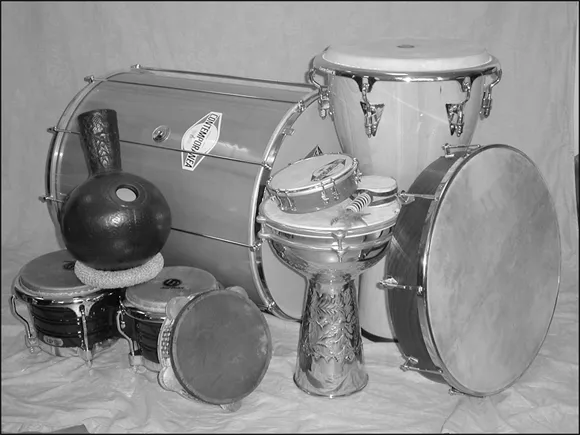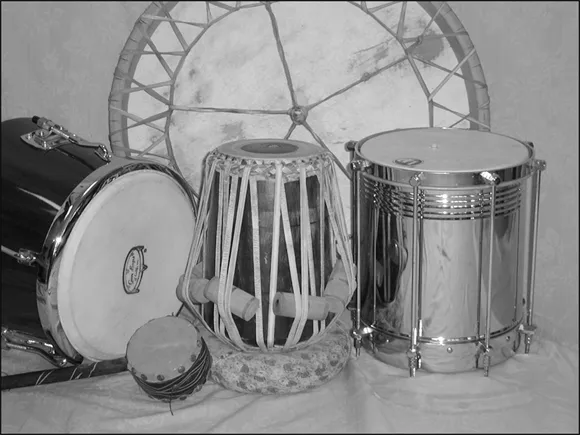![]()
Part 1
Setting a Solid Foundation
IN THIS PART …
At last, you’ve discovered that you’re a drummer at heart. Now you want to move beyond those kitchen utensils to an actual drum. Well, this part introduces you to the world of drums and drumming. In Chapter 1, you find out what makes a drum a drum and you get a glimpse of the most common styles available. Chapter 2 gives you a foundation from which to develop your drumming skills by showing you how easy it is to read music. Chapter 3 introduces you to the myriad of ways to hit a drum with a stick and shows you the fundamentals of all drumming: the rudiments (well, a few anyway — the complete list is on the Cheat Sheet). Chapter 4 helps you get a handle on hitting the drums with your hands in case you want to move beyond the drumset to more traditional drums.
![]()
Chapter 1
Drum Basics
IN THIS CHAPTER
Understanding what a drum is Discovering how a drum makes its sound Identifying the parts of a drum Recognizing the modern drumset and traditional drums Drums are members of the membraphone family of musical instruments and are considered one of the world’s oldest, dating back thousands of years … yawn. Bottom line, a drum is a musical instrument that creates a sound when you hit it. What distinguishes a drum from, say, a soup pot, is a membrane (I call it a head from now on) strung across a hollow chamber (called the shell).
Don’t get me wrong. I have nothing against soup pots. Or garbage cans or matchboxes or any other improvised drum for that matter. They can be just as fun to play and listen to as a regular drum — just look at the rhythm group Stomp; now they have fun. Face it though, a soup pot may be satisfying to hit for a little while, but sooner or later you’re gonna want a more refined sound. Enter the drum. A well-made and well-tuned drum can produce all the subtle dynamic textures of a finely crafted violin and create a variety of pleasing sounds, whereas a soup pot only clanks when you hit it.
In this chapter I introduce you to some drums, both the modern drumset and traditional styles. I also show you the difference between a drum and those kitchen appliances that you’ve probably been banging on for a while now. (It’s okay to admit it. Most drummers spend their careers exploring the rhythmic possibilities of household objects — I’m tapping on my computer mouse right now.) I also explain why a drum sounds better than a cardboard box, and I let you know when you should use your hands, or when arming yourself with sticks works better.
Picking a Drum Apart from Head to Shell
Like pots, pans, and garbage cans, drums come in all shapes and sizes. Most are round, but some are octagonal. Some are shallow and others are deep. Some are shaped like bowls or cylinders, others like goblets or an hourglass. Some you beat with sticks, while others you strike with hands or fingers. (See Figure 1-1 for a few drum shapes and sizes.) But, regardless of their shape or size, all drums consist of three basic components:
- The head (the membrane strung across the shell)
- The shell (the body of the drum)
- The hardware (the stuff that holds the other two parts together)
The look of drum hardware can vary in a lot of ways. The hardware can be as simple as tacks nailed through the head into the shell, or it can be as elaborate as gold-plated cast metal rims with bolts that are tightened to precise torque tolerances (try saying that ten times fast). Either way, they all do the same thing: They create tension on the head so that it can vibrate freely against the edge of the shell. Check out Figure 1-2 for a few hardware styles.
Exploring How Drums Create Sound
When you hit a drum, the head vibrates much the same way as a guitar string vibrates when you pluck it. And like the electric guitar when it’s not plugged into an amp, not a lot of sound comes out of the head itself, which is where the shell comes in handy. The shell acts like the amplifier that your friend uses with his or her guitar — only you don’t need to plug it in. So, you hit the drum, the head vibrates, and the sound bounces around inside the shell. This motion makes the shell vibrate too. All the sound is then projected out of the opening in the drum and, voilà! The result is the sound of sweet music. Amazingly enough, this action all happens in a fraction of a second.
How the drum sounds depends on the circumference of the head, how tightly it’s tuned, and the size, shape, and hardness of the shell. All these factors determine why drums can sound so many different ways and still be just a head, a shell, and some hardware. Without getting too technical, the size and tension of the head dictates the drum’s pitch (how high or low the drum’s tone is) while the size, shape, and hardness of the shell control the volume and timbre of the drum. Timbre is a fancy word for the quality of sound produced by an instrument. This timbre is why not all acoustic guitars or violins cost the same amount. For these instruments, the better the timbre, the higher the price. Luckily, this idea isn’t necessarily true for drums. (To find out more about the relationship between a drum’s timbre and its cost, go to Chapter 19.)
I can go on and on about how the relationship between the head and the size and shape of the shell creates particular sounds, but doing so won’t help you play the darn thing. So, the important thing to remember here is that the larger the diameter of drum, the deeper the sound, and the longer the shell, the louder the sound. As always, some exceptions exist, but for the most part you can count on this idea being true.
Deconstructing the Drumset
Once upon a time, you played drums one at a time. Each drummer played on...







